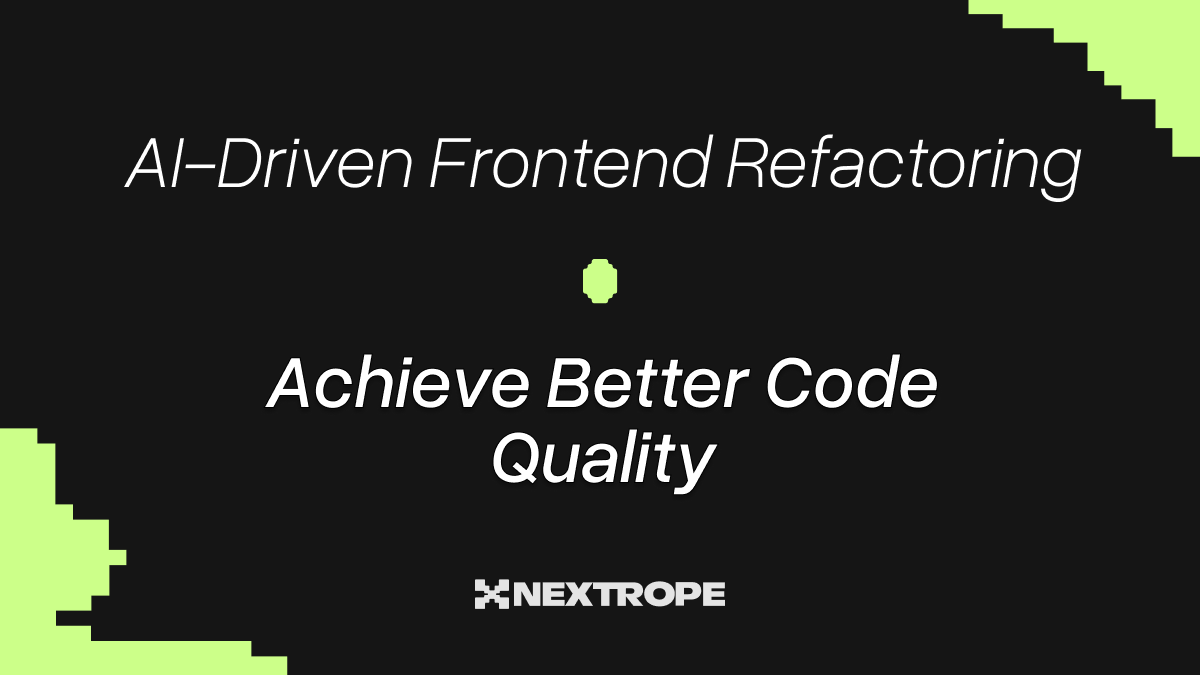Introduction
AI-Driven Frontend Refactoring is one of those tasks that most frontend developers tend to put off ‘for later.’ And honestly, it’s hard to blame them—it often requires time, focus, and… a fair amount of patience. But what if I told you that today, a large part of that process can be handled by artificial intelligence?
AI doesn’t just help us write new code anymore—it increasingly supports us in maintaining and improving existing codebases. With tools like ChatGPT, DeepSeek, Claude or Cursor, frontend refactoring with AI is no longer a tedious chore but a fast, semi-automated process.
In this article, I’ll show you how AI-Driven Frontend Refactoring can support frontend developers in code refactoring, improving readability, updating styles, and fixing bugs—and which specific tools are worth knowing.
Why Is Refactoring So Important?
Before we dive into the details, it’s worth asking: why do we even bother with refactoring in the first place?
- To improve code readability
- To make maintenance and future development easier
- To eliminate repetitive code blocks
- To prevent bugs before they happen
Refactoring is like cleaning your apartment—no one really enjoys it, but everyone knows it has to be done from time to time.
Now imagine you have a robot that does the cleaning for you.
That’s exactly what AI brings to the table.
AI-Driven Refactoring of Frontend Functions – From Complex to Simple
Let’s take a simple example – a function that does multiple things at once:
function handleUser(user) {
if (user.isLoggedIn && user.token) {
const fullName = `${user.firstName} ${user.lastName}`;
localStorage.setItem("userToken", user.token);
alert(`Welcome, ${fullName}!`);
} else {
alert("Please log in.");
}
}Request to AI: “Refactor the code to make it more readable and in line with best practices.”
AI responds:
function isAuthenticated(user) {
return user.isLoggedIn && user.token;
}
function getFullName(user) {
return `${user.firstName} ${user.lastName}`;
}
function greetUser(user) {
localStorage.setItem("userToken", user.token);
alert(`Welcome, ${getFullName(user)}!`);
}
function handleUser(user) {
if (isAuthenticated(user)) {
greetUser(user);
} else {
alert("Please log in.");
}
}This code is:
- More modular – The logic is broken down into smaller, more manageable parts (
filter()andmap()), making it easier to modify and extend. - Easier to test – With pure functions and no side effects, each part of the function can be tested independently, ensuring better maintainability and reliability.
- Ready for further development – The structure is clean, concise, and follows best practices, making it easy to add more features or handle additional requirements in the future.
AI-Driven Refactoring of Frontend Styles – From CSS to Tailwind / Styled Components
Another typical case: you want to migrate your code from traditional CSS to a newer styling approach, such as Tailwind CSS.
Original Code (CSS):
.card {
background: white;
padding: 20px;
border-radius: 8px;
box-shadow: 0px 4px 10px rgba(0,0,0,0.1);
}Request: “Convert this style to a Tailwind class.”
AI responds:
<div class="bg-white p-5 rounded-lg shadow-md"></div>And that’s it – no need to search through the documentation, no guessing which shadow fits.
AI-Driven Simplification of Frontend Component Code
You have a component that does too much, and you’d like to break it down?
function UserProfile({ user }) {
return (
<div>
<h2>{user.name}</h2>
<p>{user.email}</p>
<p>{user.bio}</p>
{user.isAdmin && <span>Admin</span>}
</div>
);
}AI might suggest:
const UserHeader = ({ name }) => <h2>{name}</h2>;
const UserInfo = ({ email, bio }) => (
<>
<p>{email}</p>
<p>{bio}</p>
</>
);
const AdminBadge = () => <span>Admin</span>;
function UserProfile({ user }) {
return (
<div>
<UserHeader name={user.name} />
<UserInfo email={user.email} bio={user.bio} />
{user.isAdmin && <AdminBadge />}
</div>
);
}Więcej komponentów = większa kontrola, lepsza czytelność.
Removing Dead Code and Unused Dependencies in Frontend with AI
AI can analyze the file structure and indicate which functions or imports are not being used.
Request: “Point out unused variables and functions in this file.”
Example of results:
// ❌ Unused import
import { calculateAge } from "../utils";
// ❌ Unused variable
const debugMode = true;This is especially useful in large projects – it saves time and reduces clutter.
Automating Refactoring Tests with AI – From Manual to Automated
AI can also help rewrite tests, for example, from manual console.log statements to proper unit tests (e.g., in Jest).
Code before:
console.log(getUserGreeting("Anna")); // should return "Hello, Anna!"Code after:
test("returns greeting for user", () => {
expect(getUserGreeting("Anna")).toBe("Hello, Anna!");
});For large applications – a huge time saver.
Tools that support AI-driven refactoring
Here are some tools that are particularly worth testing:
- ChatGPT / Claude / DeepSeek – general support, code generation, and refactoring.
- Github Copilot – automatic refactoring suggestions in the editor.
- Cursor – AI-first IDE that allows refactoring, code analysis, and working with code without leaving the editor.
Summary
Refactoring frontend code with the help of AI is not the future – it’s the present. Thanks to AI-powered tools, we can improve code quality faster, safer, and without the frustration.
Whether you want to:
- organize functions,
- simplify styles,
- detect unused imports,
- or generate tests – AI can help with that.
In the next part of the series, we’ll take a look at:
- Code review with AI: Which tools help analyze code?
- Optimizing frontend application performance with AI
- Accelerated onboarding of new developers with AI
Frontend with AI is not just about faster development – it’s also cleaner, better, and more satisfying code. If you want to learn how to create components.



